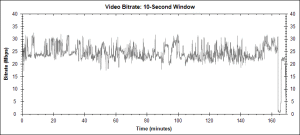I reviewed the film yesterday. Today you're reading a review of the Blu-ray. It's a complimentary review. If all movies on digital media were of this quality, I'm sure more movies would sell and retailers and distributors would be happier.
You can see the love for analog film when a director doesn't take a digital tinsel that's 2K, 4K... 48 frames and go shoot a film frame by frame so that every image has to be developed. It does bring longer processing and harder digital tricks than if everything were done all digital, but analog film belongs on the big screen where all the digital pixels in the image don't matter.
When I think back to IMAX, I've seen a few films there in both digital and analog formats. I always got more enjoyment out of the analog, which had grain. The worse was always the digital one, which had pixels.
The origin in analogue technology is evident on Blu-ray. Nolan shot his film on different types of cameras. The lowest quality is the 70mm IMAX format, which is about 60 minutes long. The rest is classic 35mm film. The two formats can be directly distinguished. IMAX will stretch to a full 16:9 monitor and the 35mm ratio is 1:2.4. The image quality and grain can also differentiate the size of the film field. The IMAX format is perfect, you can see every screw on the spaceship. 35 is more grainy and lets more of the film's qualities shine through.
As I go through frame by frame, I can't forget the lens flaws. Digital technology always strives for the perfect image. Surely Nolan's intention was to put a bit of Vignetting in the film, so that you can really tell that this is a real life film shot with "analog" cameras and it has its flaws. These flaws will certainly not be visible in the theaters, one has limited vision and will have a hard time looking at the corners of the image. For home viewing these will already show up. But it's not that big a minus, almost none. The bigger lens flaws I found were on the 60-year-old Thirst for Life, where the edges of the image were more stretched than they should have been.
Sound-wise, the film is among the top. Not only the English original, but also the Czech dubbing. The creative team led by Zdeněk Mahdal has created an adequate dubbing that would be appropriate in an IMAX theatre version. The main actor Matthew McConaughey was dubbed by Jakub Saic, the court dubber. Bondan Tůma, Libor Terš and other actors also appeared in the film. Unusually, Ladislav Frej dubs Michael Caine and Filip Jančík dubs Matt Damon. Top dubbers for the actors and minor voice alternations made for excellent dubbing.
I'm reviewing the Blu-ray which has three hours of bonus features. Among them you'll find Planning a Trip to Space, Filming in Iceland... a talk about miniatures, and more about how the film was actually made and how mathematicians and space experts helped the filmmakers. The package has 2 discs. The first is dedicated to the film only and the second contains bonus features.
Analog film and sci-fi fans should definitely buy this film. As I wrote in my review yesterday, the film's story is a bit weak and tries for a big idea that doesn't come across. But the visual orgy of the analog IMAX format makes up for any feeling the film gives you. If you're not thinking about the idea, you'll definitely enjoy seeing where the fading technology of analog film can go.
Blu-ray provided the following for review:
[adrotate banner=“29″]
You can get it straight Buy.
Bitrate

Screenshots from the Blu-ray
Original article April 6, 2015 – Kritiky.cz